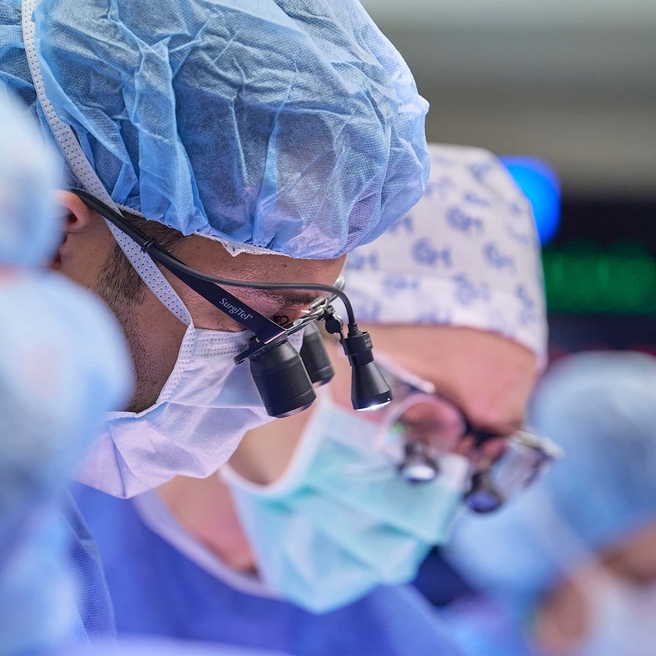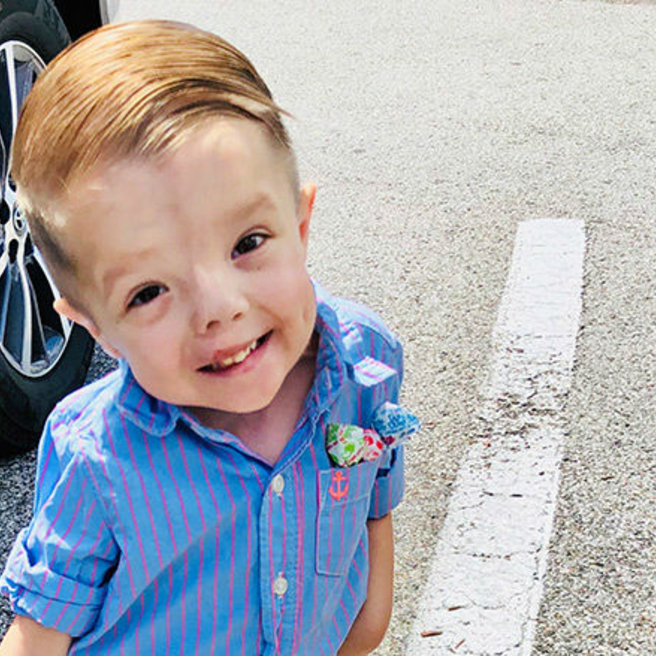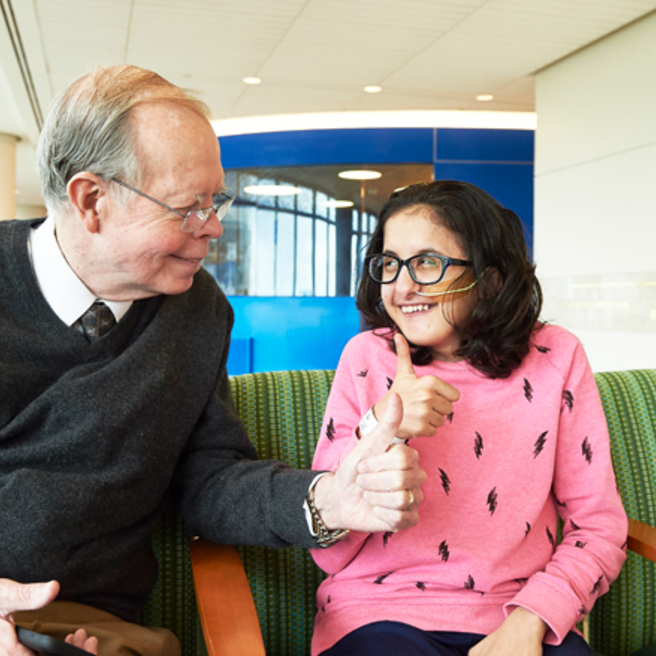What is congenital scoliosis?
Congenital scoliosis is a spinal deformity in which a sideways curvature of the spine is caused by a defect present at birth. The spine may also be rotated or twisted, pulling the ribs along with it to form a multidimensional curve.
Congenital scoliosis occurs in only 1 in 10,000 newborns and is much less common than idiopathic scoliosis, which usually becomes evident in adolescence. Congenital scoliosis may also be associated with sagittal plane abnormalities such as kyphosis and lordosis.
Causes of congenital scoliosis
In congenital scoliosis, the following may occur during the baby's development in the womb:
- The bones (vertebrae) in the spine may not form normally
- One or more bones in the spine may be absent
- Bones may partially form
- Bones may not be separated as they should be
In addition to scoliosis curves, a child’s spine may also develop other curves in the opposite direction — above or below the affected area — to compensate and maintain an upright posture.
Signs and symptoms of congenital scoliosis
Symptoms of congenital scoliosis include:
- Tilted, uneven shoulders, with one shoulder blade protruding more than the other
- A rotation of the neck causing the head to tilt in one direction
- Prominence of the ribs on one side
- Uneven waistline
- One hip higher than the other
- Overall appearance of leaning to the side
- In rare cases, there may be a problem with the spinal cord or nerves that produces weakness, numbness or a loss of coordination
Testing and diagnosis of congenital scoliosis
The term congenital scoliosis is a misleading one. It implies that there is always spinal curvature at birth, when in fact only bone malformations are present at birth in all patients with congenital scoliosis. Scoliosis may not develop until later.
Scoliosis usually is not painful, so if the curvature is not detected at birth, it can go undetected until there are obvious signs — which could be as late as adolescence. Early detection is critical for optimum outcomes.
To diagnose congenital scoliosis, a physician will conduct a thorough family and medical history, perform a physical examination of your child, and may use the following diagnostic tests:
- EOS imaging, an imaging technology that uses an ultra-low dose of radiation to create three-dimensional models from two planar images. Unlike a CT scan, EOS images are taken while the child is in an upright or standing position, enabling improved diagnosis due to weight-bearing positioning.
- X-rays are a primary diagnostic tool for scoliosis to show abnormal spinal bones and the precise angles of curvature.
- Magnetic resonance imaging (MRI) is also used in congenital scoliosis to detect problems within the bones. It uses a combination of large magnets, radiofrequencies and a computer to produce detailed images of organs and structures within the body. An MRI does not expose your child to radiation.
- Computed tomography (CT) scan which uses a combination of X-rays and computer technology to produce cross-sectional images ("slices") of the body. CT scans are helpful in detecting ribcage problems.
Children with congenital scoliosis sometimes have other health issues too, such as stomach, kidney, heart, nerve or bladder problems. This is because at the time the spine was developing in utero, other organs may also have experienced disrupted development.
Therefore, an ultrasound — using high-frequency sound waves to create an image like those taken during pregnancy of the developing baby — also may be conducted on your child’s organs to detect any anomalies.
If congenital scoliosis is detected in infancy, treatment may be initiated as early as 6 months of age. Early detection is critical for optimal outcomes. Learn more about signs and symptoms of early-onset scoliosis.
How is congenital scoliosis treated?
Bracing: most common nonsurgical treatment for congenital scoliosis
For curves less than 25 degrees, ongoing monitoring by a pediatric orthopedic doctor is generally recommended. If doctors document the child's spinal curves are worsening, spine bracing may be recommended. Bracing will reduce the pressure on your child's lower back and help straighten your child's spine. The ultimate treatment goal is to prevent the curve from progressing.
For children with curves between 25 and 40 degrees, recommended treatment will depend on your child's individual circumstances. Either spine bracing or spinal surgery may be appropriate treatment for your child.
For curves of 40 degrees or more, spinal surgery is almost always recommended.
Surgical options for congenital scoliosis
Spine surgery can dramatically improve congenital scoliosis, but it can be a stressful experience for children and families. At CHOP, we offer a wealth of resources about how to prepare your child for surgery, what to expect during surgery and specific ways we make safety in surgery a top priority.
The most common surgical treatments for congenital scoliosis are implanting growing rods and spinal fusion. The determination of which surgery is right for your child will depend on your child's age and skeletal maturity, along with a host of medical considerations.
If your child has other health issues — such as heart, lung or kidney problems — our orthopedic team will work closely with experts from cardiology, pulmonology, nephrology and other specialists to determine the order in which medical issues should be addressed.
Growing rods
For young children with congenital scoliosis, spinal surgery to implant growing rods offers a dual benefit: correcting the spinal curve and allowing continued growth of the spine.
Growing rod surgery is done through the back of the spine. In most cases, the curve in the child's back is spanned by one or two rods under the skin to avoid damaging the growth tissue of the spine. The rods are attached to the spine at two spots — above and below the curve. The growing rods will help guide spinal growth and drive the spine straight.
Every six months, the child will return to the Hospital to have the rods expanded to keep up with the child's growth and continue straightening the spine. In some cases, the growing rods may need to be replaced if the child outgrows the maximum expansion level of the rods implanted.
Spinal fusion
After your child has stopped growing — or if growing rods were not considered a viable treatment option — spinal fusion surgery may be recommended to permanently stabilize your child's spine. In this procedure, the spine is safely straightened and fused together with metal implants inserted to correct and hold the curvature.
Another option: VEPTR
In some cases, your child's congenital scoliosis may also affect your child’s rib and lung development. If this is the case, your child may also be diagnosed with thoracic insufficiency syndrome, which means your child's lungs may not expand enough to receive oxygen for their body. Without treatment, thoracic insufficiency syndrome can be fatal.
An innovative surgical device called vertical expandable prosthetic titanium ribs (VEPTR) was invented and pioneered by one of CHOP’s leading pediatric orthopedic surgeons. The VEPTR stabilizes the curved spine — while expanding the space available for the lungs — allowing the child’s ribs, spine and lungs to expand and grow.
Like growing rods, the VEPTR is surgically adjusted as your child grows and reaches skeletal maturity.
10 facts about scoliosis
A scoliosis diagnosis can leave parents with a lot of questions. Learn essential scoliosis facts parents and caregivers should know about this common, treatable condition.
Follow-up care for congenital scoliosis at CHOP
After treatment — whether surgical or nonsurgical — the clinical team at CHOP will continue to follow-up on your child's care at our Main Campus or one of our CHOP Care Network locations. CHOP was the first institution in the U.S. to introduce “EOS micro-dose” for use in scoliosis follow-up. Micro-dose uses one-third of the standard EOS radiation dose, further reducing radiation exposure for children who may require frequent imaging.
If spine bracing was required, your child will be re-evaluated every six months until their condition is stable. This usually happens after your child reaches skeletal maturity. After the spine is stabilized, annual visits to an orthopedic healthcare provider are recommended.
If your child received growing rods or VEPTR, an additional spinal fusion surgery may be necessary when they have finished growing. Annual visits to an orthopedic doctor are recommended after spinal fusion.
At Children's Hospital of Philadelphia, we offer ongoing support and services for your child and family. Our team is committed to partnering with you to provide the most current, comprehensive and specialized care possible for your child.
We also recognize your child's pediatrician as an important part of the care team, and will provide them with regular updates on the progress of your child. If continued care is necessary as your child becomes an adult, we will help transition your child's care to an adult orthopedic team.
What is the long-term outlook for children with congenital scoliosis?
By detecting congenital scoliosis early and treating it, children can have outstanding results. They can achieve normal or near-normal function and live happy, productive lives.
CHOP's approach to treatment of congenital scoliosis
At Children's Hospital of Philadelphia (CHOP), we practice family-centered care in a collaborative environment. Our multidisciplinary team of expert clinicians includes board-certified orthopedic surgeons and physicians, nurse practitioners, physician assistants, pediatric nurses, physical and occupational therapists, psychologists and many other clinical specialists. Together, we partner with you to treat your child.
Our orthopedic doctors have led and participated in many clinical studies in the area of pediatric spinal disorders. Some have invented or perfected surgical techniques used today in spinal surgeries around the world and are considered pioneers in the world of scoliosis.
CHOP's experienced orthopedic team cares for children with all types of scoliosis — from mild to the most severe. CHOP is ranked No. 1 in the nation for orthopedic care, according to U.S. News & World Report. Our team of specialists determine optimal treatment for your child based on the severity of your child's spinal curve, where the curve occurs in the spine, and your child’s age and stage of growth.

Why choose CHOP
By sharing our surgical knowledge, clinical experience and innovative research, our program offers a depth and breadth of experience treating spine conditions that is unparalleled in the region.
Resources to help
Congenital scoliosis Resources
Spine Program Resources
We have created video, audio and web resources to help you find answers to your questions and feel confident with the care you are providing your child.


